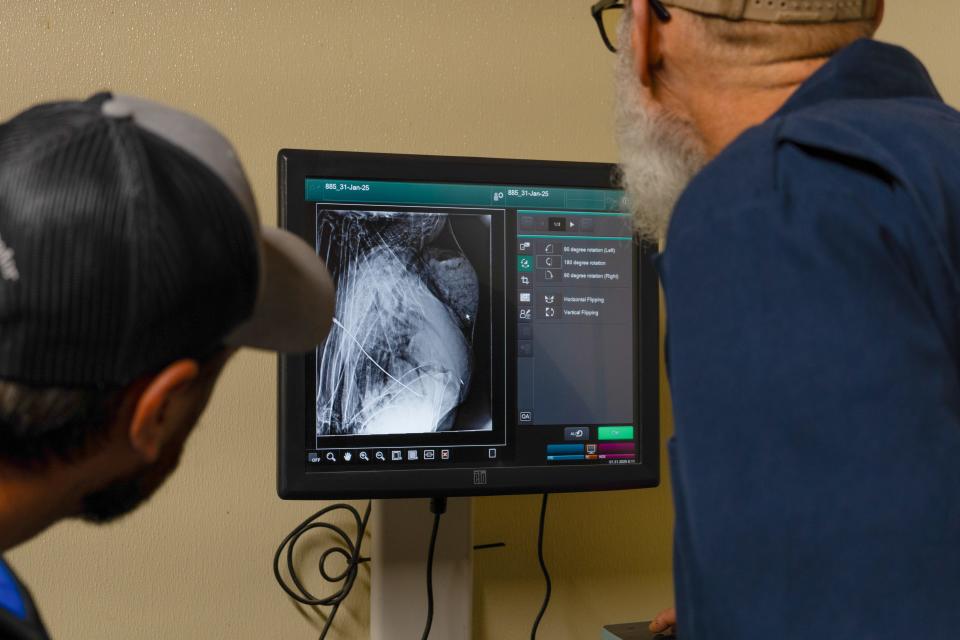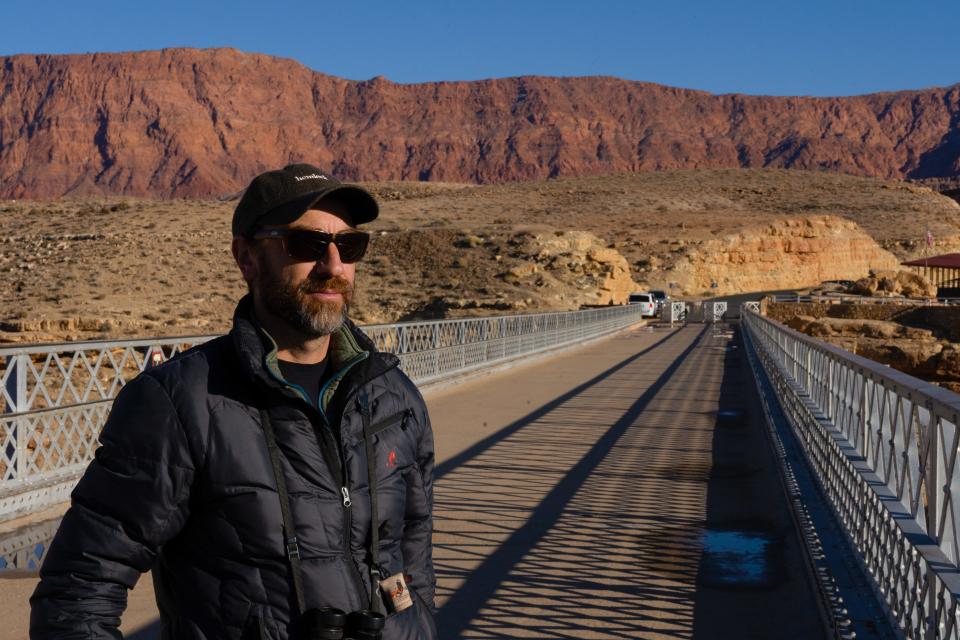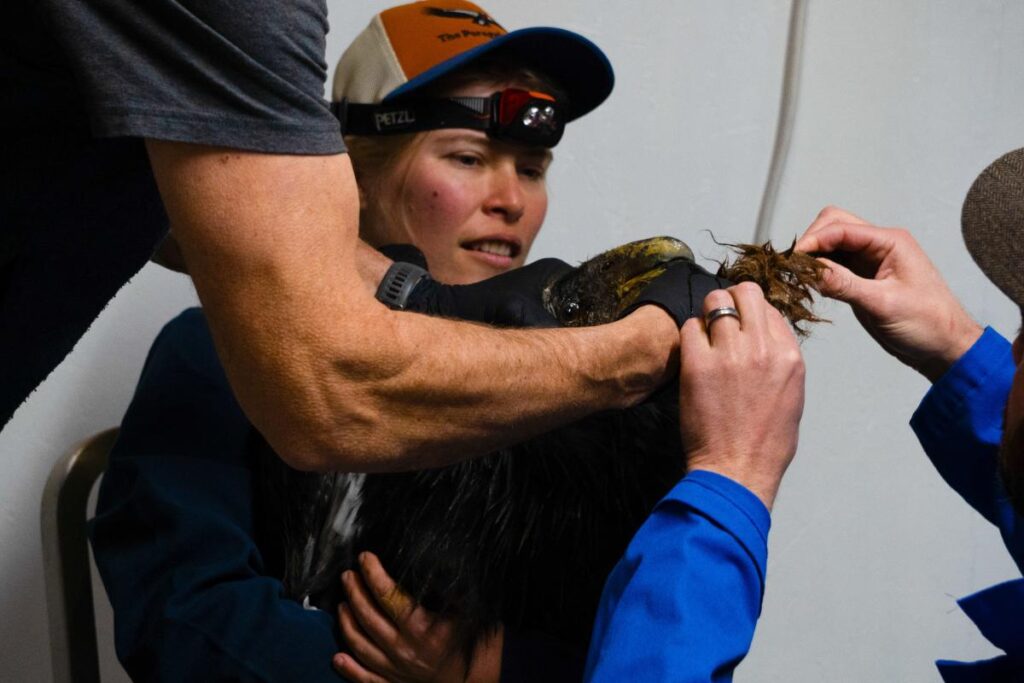MARBLE CANYON, Ariz. — Nestled among Arizona’s colossal Vermilion Cliffs, an inconspicuous building bustles with the sounds of flapping wings. Inside the remote building, no larger than a double wide mobile home, a team of dedicated biologists works overtime to sustain one of the nation’s most endangered species, the California condor.
Known to the biologists as “The Barn,” the three-room facility and attached enclosure is where wild condors are brought to receive treatment and rehabilitation from the species’ biggest threat: lead poisoning.
Inside the small examination room, Tim Hauck stands by a computer monitor viewing an x-ray of a California condor perched in the attached enclosure. Hauck is the director of the California Condor Recovery Program at the Peregrine Fund, the organization that’s permitted by the U.S. Fish and Wildlife to manage the Arizona-Utah experimental population.
With each scan, he meticulously looks for metal fragments that could be slowly poisoning the bird from the inside. The condor has likely ingested lead bullet fragments embedded in the remains of a dead animal caused by hunting or humane dispatch.
California condors are one of the most endangered species in the United States, and also one of the most highly managed. In recent years, condors in Arizona have faced recovery threats including avian flu and lead poisoning.
Recent years have been busy for the condor crew, as an outbreak of the highly pathogenic avian influenza, also known as HPAI or bird flu, resulted in the death of 21 condors in 2023 and set back recovery efforts by about a decade. Since then, biologists have incorporated new biosecurity measures as they respond to the persistent threat of lead poisoning.
On average, the Peregrine Fund team can trap and test about 75% of the flock for lead poisoning between November and February. Last year, about half of the tested birds required treatment, slightly higher than the average of 40%, according to Hauck. Data is still being collected about how lead poisoning is affecting the flock this year.
Occasionally, a condor will be treated twice within the same year, with some individuals having abnormally high amounts of the toxic metal in their digestive tracts. This is an indication that lead exposure is a regular occurrence for many of the birds, with the highest exposure periods occurring during and after the big game hunting seasons.
“Lead is our primary threat,” said Hauck. “Our number one objective is to make sure that the birds are healthy, and if they’re not, getting them healthy.”
In addition to providing treatment, the small team of biologists spends time in the field tracking the locations of the flock, monitoring their breeding and social behaviors and looking for signs of illness or distress.
Sometimes, this requires extraordinary measures, such as when the biologists hiked on foot into a remote canyon with a large animal carrier to capture condor 999 in 2022. The condor had been seriously wounded after a suspected golden eagle attack and required veterinary care from a wildlife rehabilitation center in Phoenix.
The condor, known to the staff affectionately as “Nines,” was released back into the wild, but returned to the Vermilion Cliffs facility this year for lead poisoning treatment.
“Some people would write us off as whack jobs. We’re crazy, right? We’re more dedicated to wildlife than we are to our fellow humans,” said Chris Parish, president of the Peregrine Fund, “Well that’s not true, because everything we’re doing is to make sure that the future generations have it better than we found it. And I think it brings out the best.”
As the endangered condors enter this year’s breeding season amid threats of avian flu and lead poisoning, wildlife managers are working overtime to maintain a species whose fate is closely intertwined with human activity.
The plight of the condor
A California condor’s presence cannot be ignored. The largest land bird in North America, an adult condor has a wingspan of almost 10 feet and can weigh up to 25 pounds.
Since prehistoric times, condors have soared above much of the continent, with a modern historic range stretching from British Columbia to Baja. By the mid-20th century, the population had drastically declined due to shooting, poisoning from lead and DDT pesticide, and habitat degradation.
After the passage of the Endangered Species Protection Act of 1966, the first piece of federal comprehensive endangered species legislation, the California condor was one of the first species listed in danger of extinction. By 1982, there were only 22 California condors left in the world.
Wildlife managers made a dramatic decision.
By 1987, every wild condor was captured and placed into a captive breeding program in an attempt to save the majestic species. This program would evolve into one of the most intensive wildlife management programs in U.S. history. Led by the U.S. Fish and Wildlife Service, the recovery program includes federal agencies in the United States and Mexico, state wildlife management agencies in Arizona, California, and Utah, a number of zoos and nonprofit organizations, and the Yurok Tribe in northern California.
The Yurok Tribe is one of the many indigenous cultures that consider the California condor sacred, and after initiating a reintroduction program in 2008, the tribe and its federal partners began releasing condors onto Yurok ancestral territory and Redwood National Park in 2022.
Today, there are five free-flying populations of California condors in North America: three in California, one in Mexico, and one near the border of Arizona and Utah near the Grand Canyon. In 2023, the U.S. Fish and Wildlife reported 344 California condors living in the wild, 90 of which belong to the Arizona flock.
Each wild condor wears an identifying number and a tracking device, giving wildlife managers the ability to keep close tabs on the location of each individual bird.
“Most programs are a little bit envious of our ability to track all (the condors),” said Ashleigh Blackford, the Director of the California Condor Recovery Program for the U.S. Fish and Wildlife Service. Blackford has worked on other species recovery programs for the Service and acknowledged the unique heavy management of the California condor population by the recovery teams. “Eventually, you want the species to be succeeding to the degree that you can’t do that anymore.”
To be downlisted from “endangered” to “threatened,” there must be at least two successful wild California condor populations with at least 150 individual birds, among other goals.
In the wild, a condor will reach breeding age around six years of age, and a breeding pair of condors will produce a single successful egg about once every two years. This lengthy reproductive period and high mortality caused by lead poisoning have left the condor populations struggling to reach the 150-count benchmark.
“The goal is not to be managing the flock the way we are,” said Blackford. “A lot of our close management is still related to that primary threat of lead on the landscape and being able to be responsive in our management actions.”
Lead on the landscape
By far, the largest threat to California condors in the wild is lead poisoning. Between 1992 and 2023, lead poisoning accounted for the mortality of 137 wild condors, 48% of all known deaths, according to the U.S. Fish and Wildlife Service. In the Arizona-Utah population, at least 52 individual birds have died from lead poisoning since being introduced to the region in 1996.
Lead bullets can break into thousands of small pieces as they enter an animal, and those fragments can be toxic to the wildlife that feed on the carcass or gut piles left behind by hunters, ranchers or police on the landscape.

Biologists Tim Hauck and Shawn Farry review an x-ray scan from a condor to see if any metal fragments are inside of the bird’s digestive tract. Condors can ingest toxic metals when feeding on a carcass or gut pile from an animal shot with lead ammunition.
When non-lead ammo is used, hunting can be a positive practice for the California condor population. Hunting provides a valuable food source for the condors because they are obligate scavengers, meaning they will only eat animals that are already dead.
The Arizona Game and Fish Department has had some success removing lead from the landscape. All deer, bighorn sheep, and bison hunters who draw tags in the areas where California condors soar receive a coupon for a free or discounted box of non-lead ammunition. The department also does outreach to inform hunters of the impacts of lead ammunition on wildlife.
In 2024, some 54% of successful hunters used non-lead bullets and 28% packed out animal gut piles in condor habitat, according to Erin Brown, the California condor program coordinator at Arizona Game and Fish.
Multiple challenges remain for changing the behaviors of the remaining hunters. Lead ammo can cost slightly less than the non-lead alternative, and some hunters are skeptical about its effectiveness.
“We’re seeing there are some folks who just are not interested,” said Brown, “Lead free ammunition has come a long way in the last several years. And I think folks still have an old mindset that it’s not good for the gun or it doesn’t shoot well, and that’s just not accurate anymore.”
In 2017, the Peregrine Fund, the Oregon Zoo and the Institute for Wildlife Studies established the North American Non-lead Partnership, which designs and supports voluntary measures to increase the use of non-lead ammunition among all stakeholders who use firearms outdoors.
“This campaign has been all inclusive in trying to share that information with wildlife managers, with law enforcement, with ranchers and with hunters,” said Parish of the Peregrine Fund. “A lot of people would like to take this and say it’s an attack against hunting. Well, no, it’s not meant to be. That’s how some people perceive it.”
In 2019, a law banning the use of lead ammunition in all types of hunting took effect in California. Despite this, lead poisoning continues to be a leading cause of death for condors in the state, claiming the lives of seven condors in California in 2023, according to U.S. Fish and Wildlife.
It only takes one lead-laden carcass to poison multiple members of the flock.
Known as “nature’s clean up crew,” the condors often feed on the same food source due to their highly social nature, and as opportunistic feeders, they take every chance to eat a carcass down to the bone.
“Our goal is just to provide information to hunters, let them understand their conservation impacts and whether or not they want to choose to participate,” said Brown. “And overall, as hunters continue to participate in these conservation activities, the long term impacts of removing lead fragments from the landscape are going to extend beyond California condor recovery and just make a much bigger impact on the landscape.”
Avian flu outbreak adds concerns
When the California condors began acting lethargic and fatigued in the spring of 2023, the biologists believed the birds were experiencing symptoms of lead poisoning. It wasn’t until after they brought them into the facility that they discovered the population had contracted the highly pathogenic avian influenza or bird flu.
For three weeks, the avian flu ravaged the population. The condor team was working overtime to contain the spread and treat the sick birds, often being forced to take mandatory breaks.
“It was like we were losing a bird a day. So we lost 21 birds in three weeks,” said Hauck. “When we were in it, it felt like it was a lifetime.”
It is still unclear how the condors initially contracted the avian flu, but the disease spread quickly due to their social nature.
“I wish that I had a crystal ball that could tell me how they contracted it. It seems like it was probably a fluke, and it was a rare occurrence,” said Hauck. “But it happened. And as soon as you get something like that, in a population of a bird like the condor, which is a gregarious species, the probability of it spreading through the population is really high.”

Tim Hauck, program director for the Peregrine Fund’s California Condor recovery program, stands on Navajo Bridge near Arizona’s Vermilion Cliffs, a popular condor spotting location.
As recent cases of avian flu rise in wild birds across the country, the condor team feels better prepared to respond. An emergency vaccine was approved by the U.S. Department of Agriculture, and 134 wild condors have been vaccinated by October 2024, according to the U.S. Fish and Wildlife Service.
In Arizona, the biologists discovered through testing that many of the condors in the population had contracted the avian flu during the outbreak but survived. With the existing antibodies in their systems, the condor population is better protected from similar strains of the disease.
In recent months, the outbreak of avian flu on dairy farms in California has become an emerging challenge for the condor recovery program, as dead calves are used as a supplemental food source for the birds.
“To date, we don’t have a validated way to test a stillborn calf and say it’s safe or it’s unsafe,” said Blackford of U.S. Fish and Wildlife. “We’re making more broad swath decisions based on infection levels in counties and what our State Department of Agriculture is advising us on.”
In Arizona, the Peregrine Fund’s condor team is in close communication with the group’s dairy farm partner to ensure that the dead calves they provide the condors are not infected.
Keeping the recovery efforts burning
On the night of Jan. 30, only four condors received treatment, a relatively easy night for the team, who regularly care for more than a dozen birds at a time. As the biologists enter “The Barn,” they don the coveralls hanging on the wall and swap their hiking shoes for rubber boots before two of the biologists enter the condors’ enclosure with a large hand net.
Each bird is brought inside one at a time, held carefully but firmly by a team member Hauck first checks the size of each bird’s crop, a special pouch in their throat that holds food before digestion, and then administers the lead poisoning treatment.
The condors undergo chelation therapy, in a process similar to what a human would receive for lead poisoning. The birds are injected every 12 hours with a chemical that removes toxic metal from their bodies on a weekly cycle. Their blood is tested periodically before the biologists determine if the condors are healthy enough to return to the wild.
The work is laborious, but the crew is jovial.
They know the birds on an individual level, calling them using nicknames, acknowledging their personality traits, or mentioning the similarities of the birds’ parents or siblings. On the wall, a dry erase board displays the identifying number of each California Condor in the population that has died in remembrance with the message “Keep the Fire Burnin” written alongside.
The pressure is on to get as many adult condors onto the landscape as the breeding season begins and the slow cycle to bolster the condor population continues.
In the fall, the Peregrine Fund releases California condors from its captive breeding program in Idaho into the Vermilion Cliffs’ population. Among the condors released in 2024 was condor #1221, known as Milagra (“miracle” in Spanish), whose story encapsulates the biologists’ commitment to the species.
After her mother died of avian flu and her father became sick in 2023, Milagra was collected from the wild as an egg. Defying odds through intense intervention, the egg was incubated in captivity and raised with foster parents in Idaho.
“This bird, by all accounts, should not even be here. And it is here, because of this dedicated group of individuals that cares about the species and has made it their lifelong goal to see the species recover,” said Hauck. “I think that’s really special, and that resonates with a lot of people. It brings people into the fold, and that’s ultimately what we want to do. We want to make people look at the condor as a species worthy of being on this landscape, because it almost wasn’t.”
Last September, Milagra was released back into the Vermilion Cliffs, soaring high above a cheering crowd. She has not returned for lead poisoning treatment.
John Leos covers environmental issues for The Arizona Republic and azcentral. Send tips or questions to [email protected].
Environmental coverage on azcentral.com and in The Arizona Republic is supported by a grant from the Nina Mason Pulliam Charitable Trust.
Sign up for AZ Climate, our weekly environment newsletter, and follow The Republic environmental reporting team at environment.azcentral.com and @azcenvironment on Facebook and Instagram.
This article originally appeared on Arizona Republic: In Arizona, biologists treat California condors for avian flu, lead
Read the full article here
